Macroeconomic Analysis of UK Economy: Performance and Indicators
VerifiedAdded on 2023/06/10
|10
|2761
|371
Report
AI Summary
This report provides a comprehensive overview of the UK economy, analyzing its performance through key macroeconomic indicators such as Real GDP, Real GDP growth rate, Real GDP per capita, unemployment rate, and inflation rate. It examines the performance trends of the UK economy over t...

Running head: ECONOMICS ASSIGNMENT
ECONOMICS ASSIGNMENT
Name of the Student
Name of the University
Author’s Note
ECONOMICS ASSIGNMENT
Name of the Student
Name of the University
Author’s Note
Paraphrase This Document
Need a fresh take? Get an instant paraphrase of this document with our AI Paraphraser
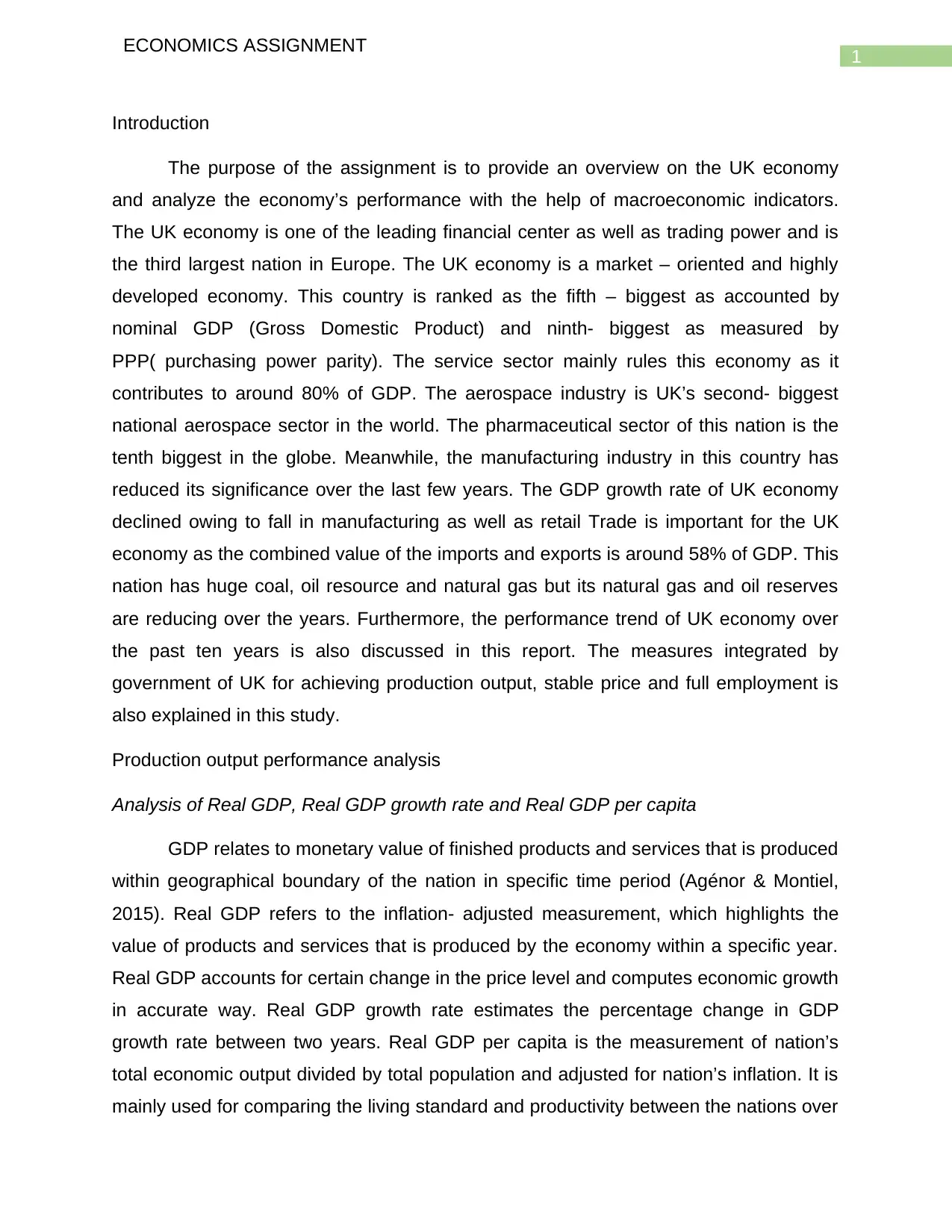
1
ECONOMICS ASSIGNMENT
Introduction
The purpose of the assignment is to provide an overview on the UK economy
and analyze the economy’s performance with the help of macroeconomic indicators.
The UK economy is one of the leading financial center as well as trading power and is
the third largest nation in Europe. The UK economy is a market – oriented and highly
developed economy. This country is ranked as the fifth – biggest as accounted by
nominal GDP (Gross Domestic Product) and ninth- biggest as measured by
PPP( purchasing power parity). The service sector mainly rules this economy as it
contributes to around 80% of GDP. The aerospace industry is UK’s second- biggest
national aerospace sector in the world. The pharmaceutical sector of this nation is the
tenth biggest in the globe. Meanwhile, the manufacturing industry in this country has
reduced its significance over the last few years. The GDP growth rate of UK economy
declined owing to fall in manufacturing as well as retail Trade is important for the UK
economy as the combined value of the imports and exports is around 58% of GDP. This
nation has huge coal, oil resource and natural gas but its natural gas and oil reserves
are reducing over the years. Furthermore, the performance trend of UK economy over
the past ten years is also discussed in this report. The measures integrated by
government of UK for achieving production output, stable price and full employment is
also explained in this study.
Production output performance analysis
Analysis of Real GDP, Real GDP growth rate and Real GDP per capita
GDP relates to monetary value of finished products and services that is produced
within geographical boundary of the nation in specific time period (Agénor & Montiel,
2015). Real GDP refers to the inflation- adjusted measurement, which highlights the
value of products and services that is produced by the economy within a specific year.
Real GDP accounts for certain change in the price level and computes economic growth
in accurate way. Real GDP growth rate estimates the percentage change in GDP
growth rate between two years. Real GDP per capita is the measurement of nation’s
total economic output divided by total population and adjusted for nation’s inflation. It is
mainly used for comparing the living standard and productivity between the nations over
ECONOMICS ASSIGNMENT
Introduction
The purpose of the assignment is to provide an overview on the UK economy
and analyze the economy’s performance with the help of macroeconomic indicators.
The UK economy is one of the leading financial center as well as trading power and is
the third largest nation in Europe. The UK economy is a market – oriented and highly
developed economy. This country is ranked as the fifth – biggest as accounted by
nominal GDP (Gross Domestic Product) and ninth- biggest as measured by
PPP( purchasing power parity). The service sector mainly rules this economy as it
contributes to around 80% of GDP. The aerospace industry is UK’s second- biggest
national aerospace sector in the world. The pharmaceutical sector of this nation is the
tenth biggest in the globe. Meanwhile, the manufacturing industry in this country has
reduced its significance over the last few years. The GDP growth rate of UK economy
declined owing to fall in manufacturing as well as retail Trade is important for the UK
economy as the combined value of the imports and exports is around 58% of GDP. This
nation has huge coal, oil resource and natural gas but its natural gas and oil reserves
are reducing over the years. Furthermore, the performance trend of UK economy over
the past ten years is also discussed in this report. The measures integrated by
government of UK for achieving production output, stable price and full employment is
also explained in this study.
Production output performance analysis
Analysis of Real GDP, Real GDP growth rate and Real GDP per capita
GDP relates to monetary value of finished products and services that is produced
within geographical boundary of the nation in specific time period (Agénor & Montiel,
2015). Real GDP refers to the inflation- adjusted measurement, which highlights the
value of products and services that is produced by the economy within a specific year.
Real GDP accounts for certain change in the price level and computes economic growth
in accurate way. Real GDP growth rate estimates the percentage change in GDP
growth rate between two years. Real GDP per capita is the measurement of nation’s
total economic output divided by total population and adjusted for nation’s inflation. It is
mainly used for comparing the living standard and productivity between the nations over

2
ECONOMICS ASSIGNMENT
time. The government of respective nations utilizes this macroeconomic indicator to
analyze purchasing power as well as growth of nation (Mankiw, 2014).
Explaining how each indicator measures economy’s performance
Real GDP has been considered as better macroeconomic indicator as it helps to
measure the economy’s performance since it includes fluctuating commodity value that
is expressed in form of money. It provides an idea about total output of the country with
decline in distortion due to specific factors that involves- inflation, currency rate
fluctuations. On the other hand, real GDP per capita is specifically useful to make cross-
nation comparisons of economic well- being and average standard of living of the
people. An increase in real per capita GDP signifies economy’s growth and also tends
to highlight rise in total productivity (Mankiw, 2014). This indicator does not take into
account technology impact on production output and income distribution in the nation.
Moreover, these macroeconomic indicators also help to forecast recession in the
country in accurate way.
Performance trends of UK economy
The UK economy’s performance has shown upward trends since the global
financial crisis but the growth remains sluggish over the last few years. The real GDP
growth rate of UK averaged to near about 0.60% over the last few decades. The real
GDP growth rate remained stable except during the recession period (2008-09), in
which the rate became negative. This nation’s retail as well as service industry mainly
contributed to slow growth rate of real GDP over the years. This industry increased by
near about 0.8% in the year 2016 but the growth rate slowed down to about 0.3% from
the orevious years. The production industry in UK has also declined in the year 2014
from last year. Deceleration in these industries occurred owing to rise in prices. Even
the currency value declined by about 15% to 20% after the Brexit. The real GDP per
capita in this country averaged to about 27854.99 USD from the past ten years. During
the year 2005 to 2014, the real GDP per capita of this nation increased at high rate. The
competitive pound value and stronger global nations have enhanced UK inbound
tourism and exports, which offers support for UK GDP growth.
ECONOMICS ASSIGNMENT
time. The government of respective nations utilizes this macroeconomic indicator to
analyze purchasing power as well as growth of nation (Mankiw, 2014).
Explaining how each indicator measures economy’s performance
Real GDP has been considered as better macroeconomic indicator as it helps to
measure the economy’s performance since it includes fluctuating commodity value that
is expressed in form of money. It provides an idea about total output of the country with
decline in distortion due to specific factors that involves- inflation, currency rate
fluctuations. On the other hand, real GDP per capita is specifically useful to make cross-
nation comparisons of economic well- being and average standard of living of the
people. An increase in real per capita GDP signifies economy’s growth and also tends
to highlight rise in total productivity (Mankiw, 2014). This indicator does not take into
account technology impact on production output and income distribution in the nation.
Moreover, these macroeconomic indicators also help to forecast recession in the
country in accurate way.
Performance trends of UK economy
The UK economy’s performance has shown upward trends since the global
financial crisis but the growth remains sluggish over the last few years. The real GDP
growth rate of UK averaged to near about 0.60% over the last few decades. The real
GDP growth rate remained stable except during the recession period (2008-09), in
which the rate became negative. This nation’s retail as well as service industry mainly
contributed to slow growth rate of real GDP over the years. This industry increased by
near about 0.8% in the year 2016 but the growth rate slowed down to about 0.3% from
the orevious years. The production industry in UK has also declined in the year 2014
from last year. Deceleration in these industries occurred owing to rise in prices. Even
the currency value declined by about 15% to 20% after the Brexit. The real GDP per
capita in this country averaged to about 27854.99 USD from the past ten years. During
the year 2005 to 2014, the real GDP per capita of this nation increased at high rate. The
competitive pound value and stronger global nations have enhanced UK inbound
tourism and exports, which offers support for UK GDP growth.
⊘ This is a preview!⊘
Do you want full access?
Subscribe today to unlock all pages.

Trusted by 1+ million students worldwide
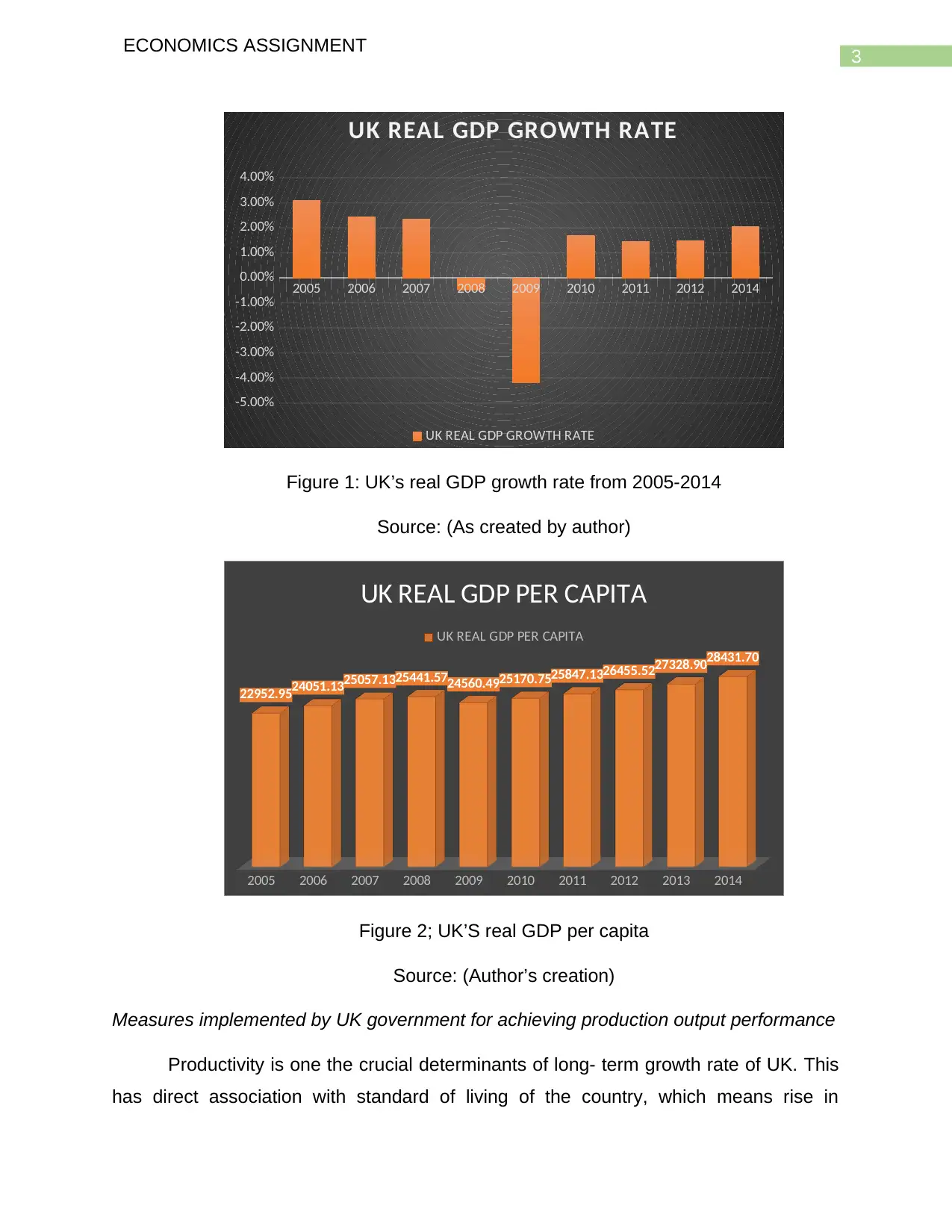
3
ECONOMICS ASSIGNMENT
2005 2006 2007 2008 2009 2010 2011 2012 2014
-5.00%
-4.00%
-3.00%
-2.00%
-1.00%
0.00%
1.00%
2.00%
3.00%
4.00%
UK REAL GDP GROWTH RATE
UK REAL GDP GROWTH RATE
Figure 1: UK’s real GDP growth rate from 2005-2014
Source: (As created by author)
2005 2006 2007 2008 2009 2010 2011 2012 2013 2014
22952.9524051.1325057.1325441.5724560.4925170.7525847.1326455.5227328.9028431.70
UK REAL GDP PER CAPITA
UK REAL GDP PER CAPITA
Figure 2; UK’S real GDP per capita
Source: (Author’s creation)
Measures implemented by UK government for achieving production output performance
Productivity is one the crucial determinants of long- term growth rate of UK. This
has direct association with standard of living of the country, which means rise in
ECONOMICS ASSIGNMENT
2005 2006 2007 2008 2009 2010 2011 2012 2014
-5.00%
-4.00%
-3.00%
-2.00%
-1.00%
0.00%
1.00%
2.00%
3.00%
4.00%
UK REAL GDP GROWTH RATE
UK REAL GDP GROWTH RATE
Figure 1: UK’s real GDP growth rate from 2005-2014
Source: (As created by author)
2005 2006 2007 2008 2009 2010 2011 2012 2013 2014
22952.9524051.1325057.1325441.5724560.4925170.7525847.1326455.5227328.9028431.70
UK REAL GDP PER CAPITA
UK REAL GDP PER CAPITA
Figure 2; UK’S real GDP per capita
Source: (Author’s creation)
Measures implemented by UK government for achieving production output performance
Productivity is one the crucial determinants of long- term growth rate of UK. This
has direct association with standard of living of the country, which means rise in
Paraphrase This Document
Need a fresh take? Get an instant paraphrase of this document with our AI Paraphraser
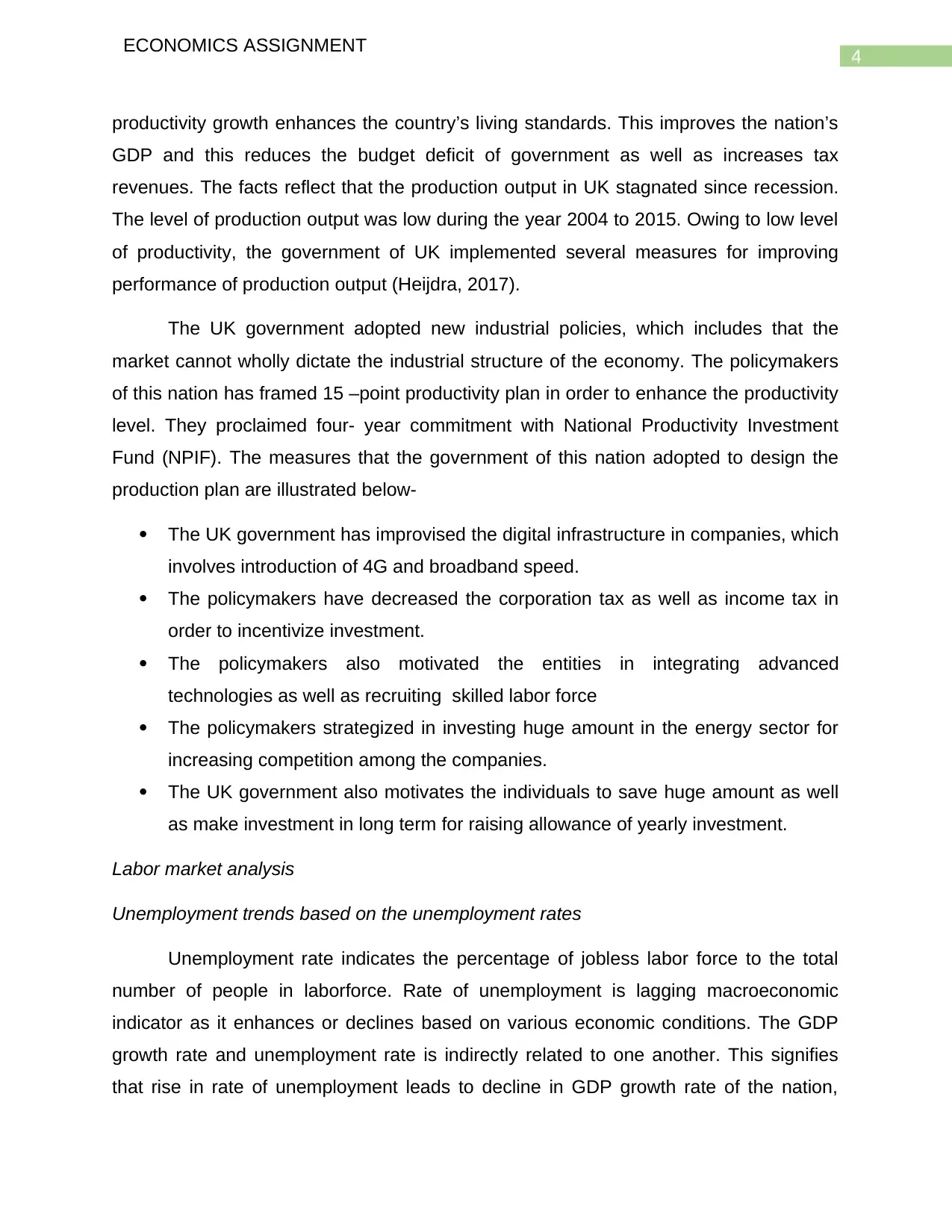
4
ECONOMICS ASSIGNMENT
productivity growth enhances the country’s living standards. This improves the nation’s
GDP and this reduces the budget deficit of government as well as increases tax
revenues. The facts reflect that the production output in UK stagnated since recession.
The level of production output was low during the year 2004 to 2015. Owing to low level
of productivity, the government of UK implemented several measures for improving
performance of production output (Heijdra, 2017).
The UK government adopted new industrial policies, which includes that the
market cannot wholly dictate the industrial structure of the economy. The policymakers
of this nation has framed 15 –point productivity plan in order to enhance the productivity
level. They proclaimed four- year commitment with National Productivity Investment
Fund (NPIF). The measures that the government of this nation adopted to design the
production plan are illustrated below-
The UK government has improvised the digital infrastructure in companies, which
involves introduction of 4G and broadband speed.
The policymakers have decreased the corporation tax as well as income tax in
order to incentivize investment.
The policymakers also motivated the entities in integrating advanced
technologies as well as recruiting skilled labor force
The policymakers strategized in investing huge amount in the energy sector for
increasing competition among the companies.
The UK government also motivates the individuals to save huge amount as well
as make investment in long term for raising allowance of yearly investment.
Labor market analysis
Unemployment trends based on the unemployment rates
Unemployment rate indicates the percentage of jobless labor force to the total
number of people in laborforce. Rate of unemployment is lagging macroeconomic
indicator as it enhances or declines based on various economic conditions. The GDP
growth rate and unemployment rate is indirectly related to one another. This signifies
that rise in rate of unemployment leads to decline in GDP growth rate of the nation,
ECONOMICS ASSIGNMENT
productivity growth enhances the country’s living standards. This improves the nation’s
GDP and this reduces the budget deficit of government as well as increases tax
revenues. The facts reflect that the production output in UK stagnated since recession.
The level of production output was low during the year 2004 to 2015. Owing to low level
of productivity, the government of UK implemented several measures for improving
performance of production output (Heijdra, 2017).
The UK government adopted new industrial policies, which includes that the
market cannot wholly dictate the industrial structure of the economy. The policymakers
of this nation has framed 15 –point productivity plan in order to enhance the productivity
level. They proclaimed four- year commitment with National Productivity Investment
Fund (NPIF). The measures that the government of this nation adopted to design the
production plan are illustrated below-
The UK government has improvised the digital infrastructure in companies, which
involves introduction of 4G and broadband speed.
The policymakers have decreased the corporation tax as well as income tax in
order to incentivize investment.
The policymakers also motivated the entities in integrating advanced
technologies as well as recruiting skilled labor force
The policymakers strategized in investing huge amount in the energy sector for
increasing competition among the companies.
The UK government also motivates the individuals to save huge amount as well
as make investment in long term for raising allowance of yearly investment.
Labor market analysis
Unemployment trends based on the unemployment rates
Unemployment rate indicates the percentage of jobless labor force to the total
number of people in laborforce. Rate of unemployment is lagging macroeconomic
indicator as it enhances or declines based on various economic conditions. The GDP
growth rate and unemployment rate is indirectly related to one another. This signifies
that rise in rate of unemployment leads to decline in GDP growth rate of the nation,
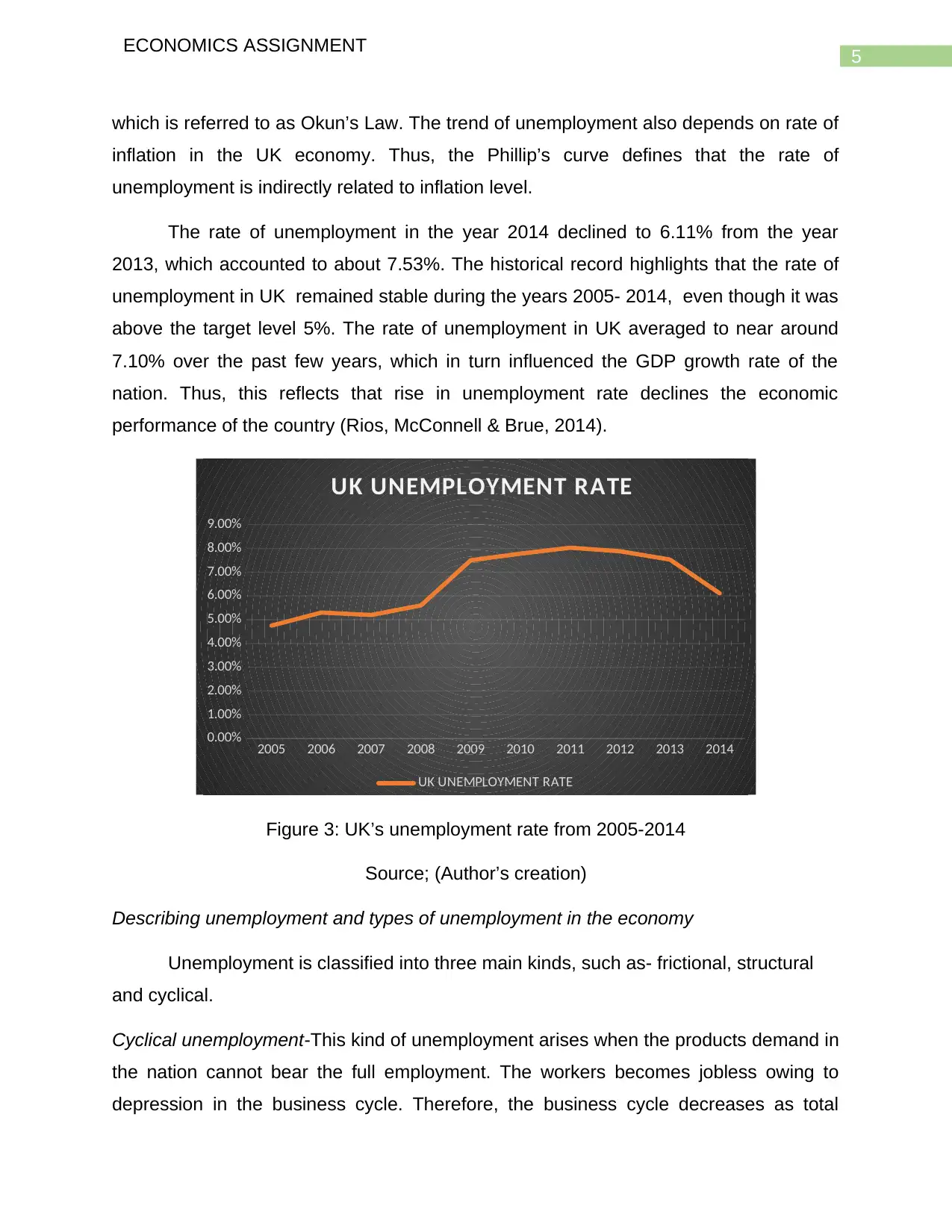
5
ECONOMICS ASSIGNMENT
which is referred to as Okun’s Law. The trend of unemployment also depends on rate of
inflation in the UK economy. Thus, the Phillip’s curve defines that the rate of
unemployment is indirectly related to inflation level.
The rate of unemployment in the year 2014 declined to 6.11% from the year
2013, which accounted to about 7.53%. The historical record highlights that the rate of
unemployment in UK remained stable during the years 2005- 2014, even though it was
above the target level 5%. The rate of unemployment in UK averaged to near around
7.10% over the past few years, which in turn influenced the GDP growth rate of the
nation. Thus, this reflects that rise in unemployment rate declines the economic
performance of the country (Rios, McConnell & Brue, 2014).
2005 2006 2007 2008 2009 2010 2011 2012 2013 2014
0.00%
1.00%
2.00%
3.00%
4.00%
5.00%
6.00%
7.00%
8.00%
9.00%
UK UNEMPLOYMENT RATE
UK UNEMPLOYMENT RATE
Figure 3: UK’s unemployment rate from 2005-2014
Source; (Author’s creation)
Describing unemployment and types of unemployment in the economy
Unemployment is classified into three main kinds, such as- frictional, structural
and cyclical.
Cyclical unemployment-This kind of unemployment arises when the products demand in
the nation cannot bear the full employment. The workers becomes jobless owing to
depression in the business cycle. Therefore, the business cycle decreases as total
ECONOMICS ASSIGNMENT
which is referred to as Okun’s Law. The trend of unemployment also depends on rate of
inflation in the UK economy. Thus, the Phillip’s curve defines that the rate of
unemployment is indirectly related to inflation level.
The rate of unemployment in the year 2014 declined to 6.11% from the year
2013, which accounted to about 7.53%. The historical record highlights that the rate of
unemployment in UK remained stable during the years 2005- 2014, even though it was
above the target level 5%. The rate of unemployment in UK averaged to near around
7.10% over the past few years, which in turn influenced the GDP growth rate of the
nation. Thus, this reflects that rise in unemployment rate declines the economic
performance of the country (Rios, McConnell & Brue, 2014).
2005 2006 2007 2008 2009 2010 2011 2012 2013 2014
0.00%
1.00%
2.00%
3.00%
4.00%
5.00%
6.00%
7.00%
8.00%
9.00%
UK UNEMPLOYMENT RATE
UK UNEMPLOYMENT RATE
Figure 3: UK’s unemployment rate from 2005-2014
Source; (Author’s creation)
Describing unemployment and types of unemployment in the economy
Unemployment is classified into three main kinds, such as- frictional, structural
and cyclical.
Cyclical unemployment-This kind of unemployment arises when the products demand in
the nation cannot bear the full employment. The workers becomes jobless owing to
depression in the business cycle. Therefore, the business cycle decreases as total
⊘ This is a preview!⊘
Do you want full access?
Subscribe today to unlock all pages.

Trusted by 1+ million students worldwide
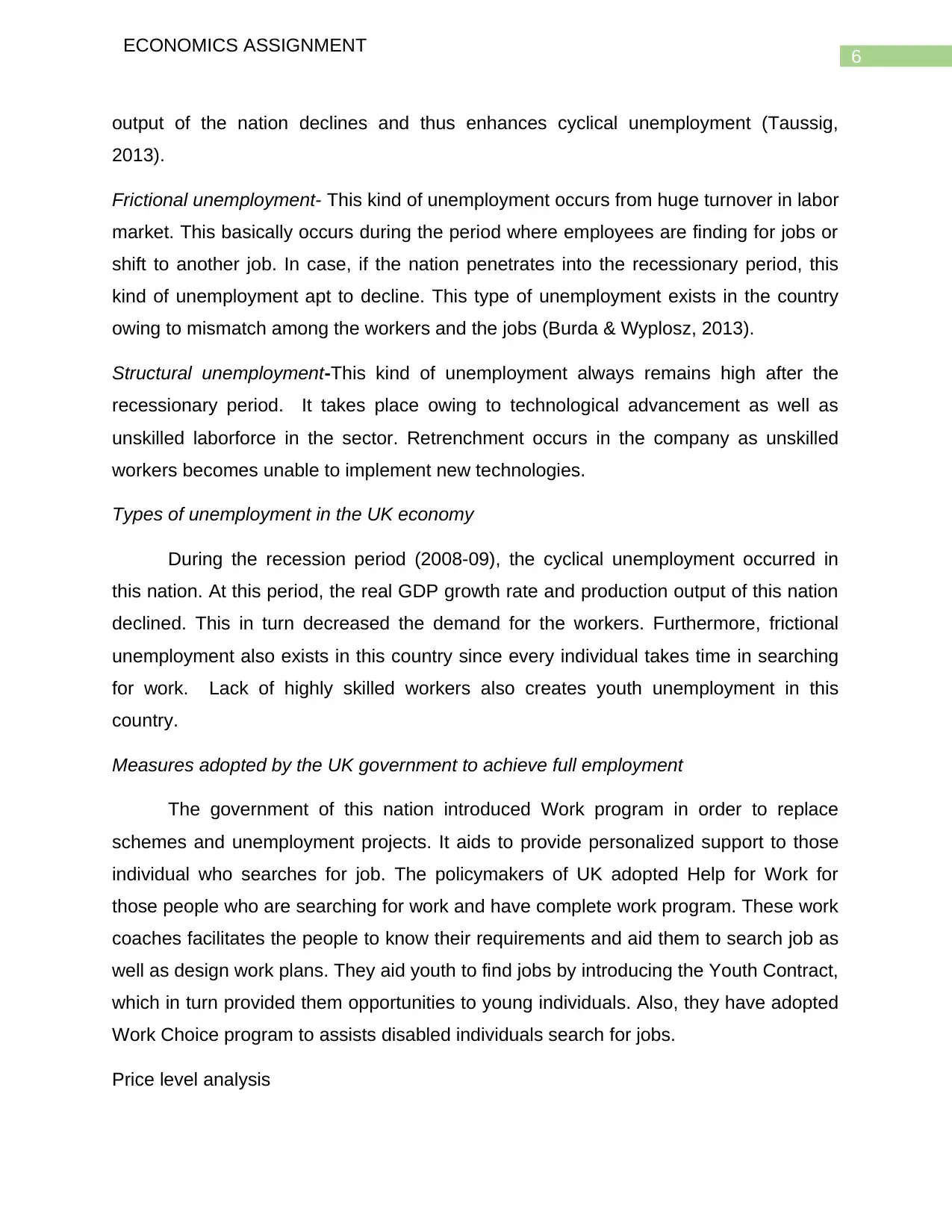
6
ECONOMICS ASSIGNMENT
output of the nation declines and thus enhances cyclical unemployment (Taussig,
2013).
Frictional unemployment- This kind of unemployment occurs from huge turnover in labor
market. This basically occurs during the period where employees are finding for jobs or
shift to another job. In case, if the nation penetrates into the recessionary period, this
kind of unemployment apt to decline. This type of unemployment exists in the country
owing to mismatch among the workers and the jobs (Burda & Wyplosz, 2013).
Structural unemployment-This kind of unemployment always remains high after the
recessionary period. It takes place owing to technological advancement as well as
unskilled laborforce in the sector. Retrenchment occurs in the company as unskilled
workers becomes unable to implement new technologies.
Types of unemployment in the UK economy
During the recession period (2008-09), the cyclical unemployment occurred in
this nation. At this period, the real GDP growth rate and production output of this nation
declined. This in turn decreased the demand for the workers. Furthermore, frictional
unemployment also exists in this country since every individual takes time in searching
for work. Lack of highly skilled workers also creates youth unemployment in this
country.
Measures adopted by the UK government to achieve full employment
The government of this nation introduced Work program in order to replace
schemes and unemployment projects. It aids to provide personalized support to those
individual who searches for job. The policymakers of UK adopted Help for Work for
those people who are searching for work and have complete work program. These work
coaches facilitates the people to know their requirements and aid them to search job as
well as design work plans. They aid youth to find jobs by introducing the Youth Contract,
which in turn provided them opportunities to young individuals. Also, they have adopted
Work Choice program to assists disabled individuals search for jobs.
Price level analysis
ECONOMICS ASSIGNMENT
output of the nation declines and thus enhances cyclical unemployment (Taussig,
2013).
Frictional unemployment- This kind of unemployment occurs from huge turnover in labor
market. This basically occurs during the period where employees are finding for jobs or
shift to another job. In case, if the nation penetrates into the recessionary period, this
kind of unemployment apt to decline. This type of unemployment exists in the country
owing to mismatch among the workers and the jobs (Burda & Wyplosz, 2013).
Structural unemployment-This kind of unemployment always remains high after the
recessionary period. It takes place owing to technological advancement as well as
unskilled laborforce in the sector. Retrenchment occurs in the company as unskilled
workers becomes unable to implement new technologies.
Types of unemployment in the UK economy
During the recession period (2008-09), the cyclical unemployment occurred in
this nation. At this period, the real GDP growth rate and production output of this nation
declined. This in turn decreased the demand for the workers. Furthermore, frictional
unemployment also exists in this country since every individual takes time in searching
for work. Lack of highly skilled workers also creates youth unemployment in this
country.
Measures adopted by the UK government to achieve full employment
The government of this nation introduced Work program in order to replace
schemes and unemployment projects. It aids to provide personalized support to those
individual who searches for job. The policymakers of UK adopted Help for Work for
those people who are searching for work and have complete work program. These work
coaches facilitates the people to know their requirements and aid them to search job as
well as design work plans. They aid youth to find jobs by introducing the Youth Contract,
which in turn provided them opportunities to young individuals. Also, they have adopted
Work Choice program to assists disabled individuals search for jobs.
Price level analysis
Paraphrase This Document
Need a fresh take? Get an instant paraphrase of this document with our AI Paraphraser
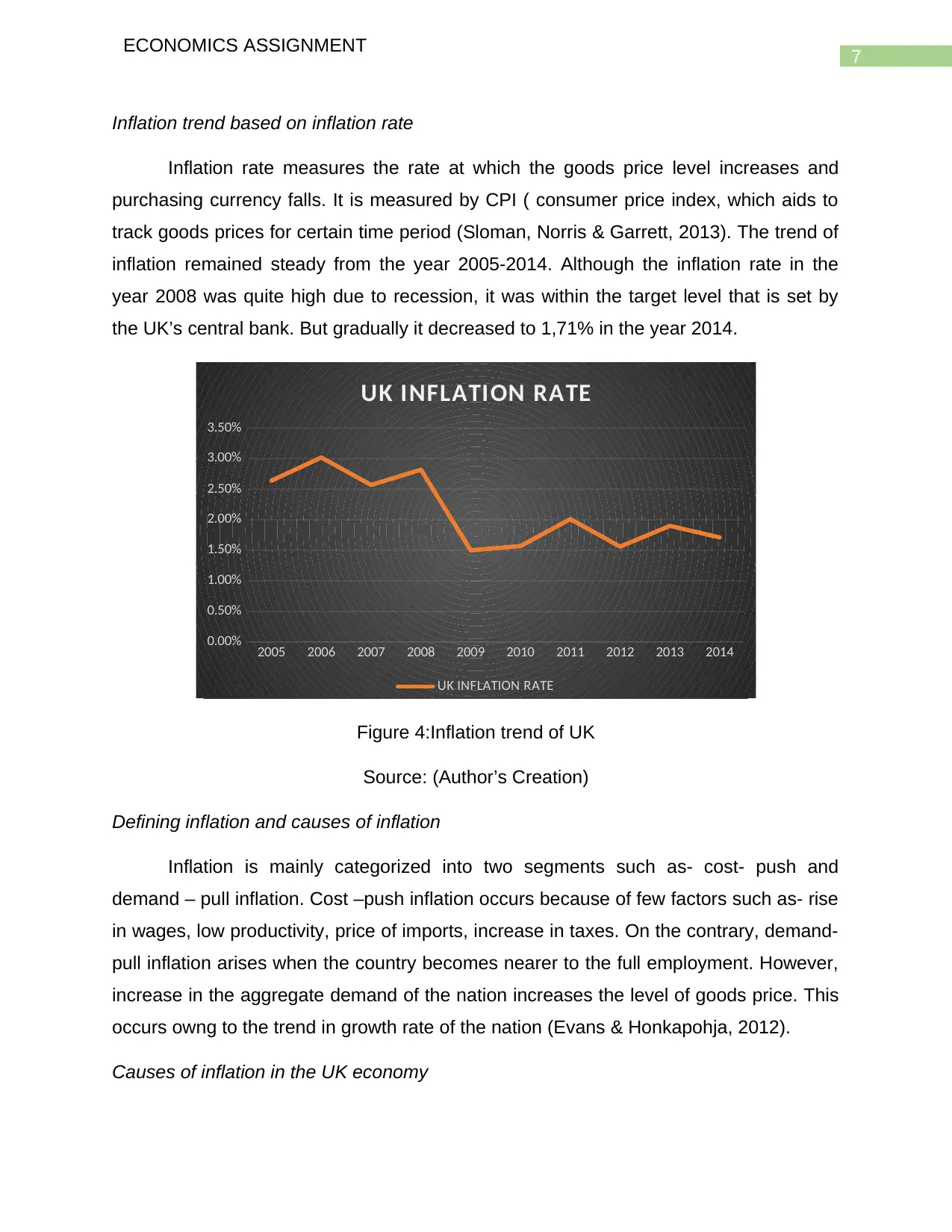
7
ECONOMICS ASSIGNMENT
Inflation trend based on inflation rate
Inflation rate measures the rate at which the goods price level increases and
purchasing currency falls. It is measured by CPI ( consumer price index, which aids to
track goods prices for certain time period (Sloman, Norris & Garrett, 2013). The trend of
inflation remained steady from the year 2005-2014. Although the inflation rate in the
year 2008 was quite high due to recession, it was within the target level that is set by
the UK’s central bank. But gradually it decreased to 1,71% in the year 2014.
2005 2006 2007 2008 2009 2010 2011 2012 2013 2014
0.00%
0.50%
1.00%
1.50%
2.00%
2.50%
3.00%
3.50%
UK INFLATION RATE
UK INFLATION RATE
Figure 4:Inflation trend of UK
Source: (Author’s Creation)
Defining inflation and causes of inflation
Inflation is mainly categorized into two segments such as- cost- push and
demand – pull inflation. Cost –push inflation occurs because of few factors such as- rise
in wages, low productivity, price of imports, increase in taxes. On the contrary, demand-
pull inflation arises when the country becomes nearer to the full employment. However,
increase in the aggregate demand of the nation increases the level of goods price. This
occurs owng to the trend in growth rate of the nation (Evans & Honkapohja, 2012).
Causes of inflation in the UK economy
ECONOMICS ASSIGNMENT
Inflation trend based on inflation rate
Inflation rate measures the rate at which the goods price level increases and
purchasing currency falls. It is measured by CPI ( consumer price index, which aids to
track goods prices for certain time period (Sloman, Norris & Garrett, 2013). The trend of
inflation remained steady from the year 2005-2014. Although the inflation rate in the
year 2008 was quite high due to recession, it was within the target level that is set by
the UK’s central bank. But gradually it decreased to 1,71% in the year 2014.
2005 2006 2007 2008 2009 2010 2011 2012 2013 2014
0.00%
0.50%
1.00%
1.50%
2.00%
2.50%
3.00%
3.50%
UK INFLATION RATE
UK INFLATION RATE
Figure 4:Inflation trend of UK
Source: (Author’s Creation)
Defining inflation and causes of inflation
Inflation is mainly categorized into two segments such as- cost- push and
demand – pull inflation. Cost –push inflation occurs because of few factors such as- rise
in wages, low productivity, price of imports, increase in taxes. On the contrary, demand-
pull inflation arises when the country becomes nearer to the full employment. However,
increase in the aggregate demand of the nation increases the level of goods price. This
occurs owng to the trend in growth rate of the nation (Evans & Honkapohja, 2012).
Causes of inflation in the UK economy
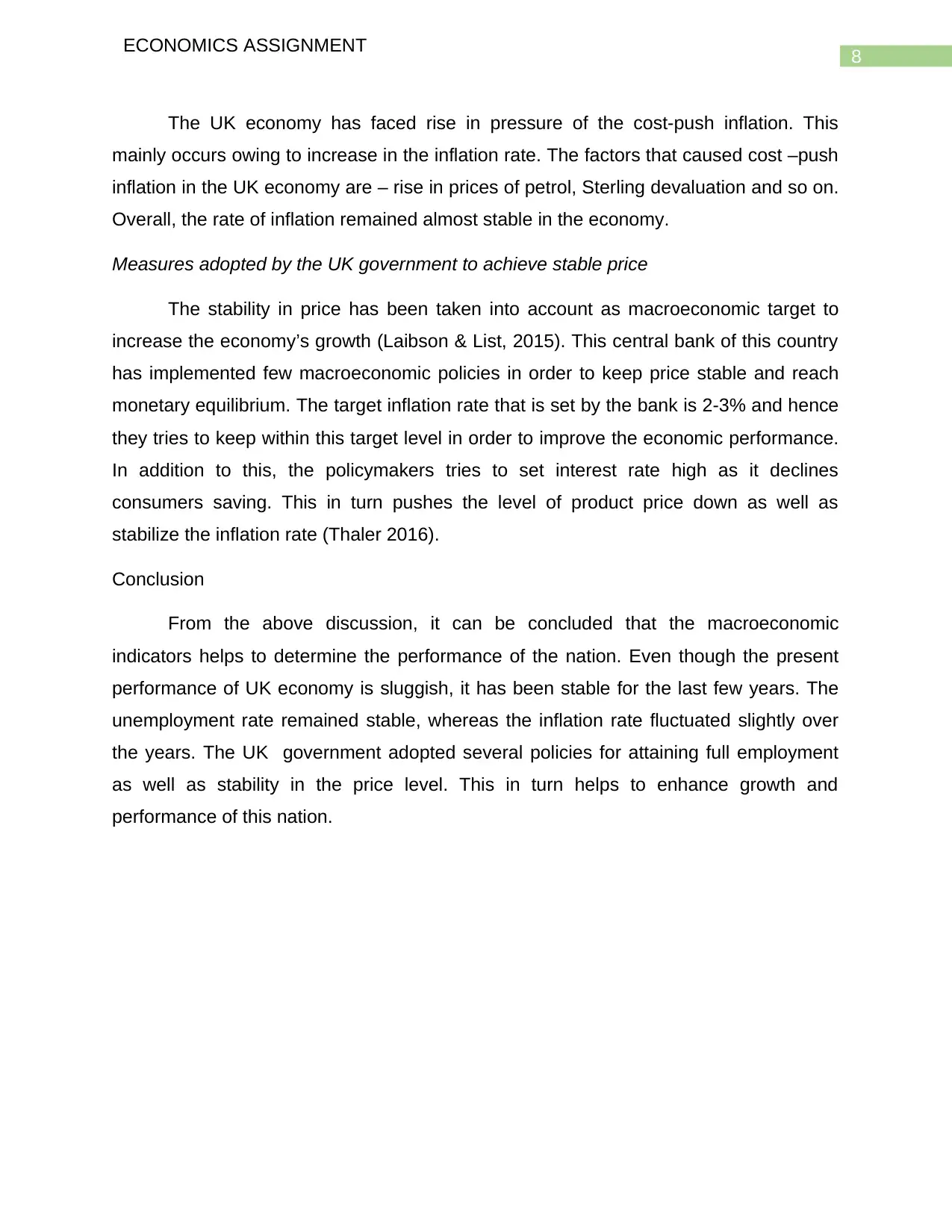
8
ECONOMICS ASSIGNMENT
The UK economy has faced rise in pressure of the cost-push inflation. This
mainly occurs owing to increase in the inflation rate. The factors that caused cost –push
inflation in the UK economy are – rise in prices of petrol, Sterling devaluation and so on.
Overall, the rate of inflation remained almost stable in the economy.
Measures adopted by the UK government to achieve stable price
The stability in price has been taken into account as macroeconomic target to
increase the economy’s growth (Laibson & List, 2015). This central bank of this country
has implemented few macroeconomic policies in order to keep price stable and reach
monetary equilibrium. The target inflation rate that is set by the bank is 2-3% and hence
they tries to keep within this target level in order to improve the economic performance.
In addition to this, the policymakers tries to set interest rate high as it declines
consumers saving. This in turn pushes the level of product price down as well as
stabilize the inflation rate (Thaler 2016).
Conclusion
From the above discussion, it can be concluded that the macroeconomic
indicators helps to determine the performance of the nation. Even though the present
performance of UK economy is sluggish, it has been stable for the last few years. The
unemployment rate remained stable, whereas the inflation rate fluctuated slightly over
the years. The UK government adopted several policies for attaining full employment
as well as stability in the price level. This in turn helps to enhance growth and
performance of this nation.
ECONOMICS ASSIGNMENT
The UK economy has faced rise in pressure of the cost-push inflation. This
mainly occurs owing to increase in the inflation rate. The factors that caused cost –push
inflation in the UK economy are – rise in prices of petrol, Sterling devaluation and so on.
Overall, the rate of inflation remained almost stable in the economy.
Measures adopted by the UK government to achieve stable price
The stability in price has been taken into account as macroeconomic target to
increase the economy’s growth (Laibson & List, 2015). This central bank of this country
has implemented few macroeconomic policies in order to keep price stable and reach
monetary equilibrium. The target inflation rate that is set by the bank is 2-3% and hence
they tries to keep within this target level in order to improve the economic performance.
In addition to this, the policymakers tries to set interest rate high as it declines
consumers saving. This in turn pushes the level of product price down as well as
stabilize the inflation rate (Thaler 2016).
Conclusion
From the above discussion, it can be concluded that the macroeconomic
indicators helps to determine the performance of the nation. Even though the present
performance of UK economy is sluggish, it has been stable for the last few years. The
unemployment rate remained stable, whereas the inflation rate fluctuated slightly over
the years. The UK government adopted several policies for attaining full employment
as well as stability in the price level. This in turn helps to enhance growth and
performance of this nation.
⊘ This is a preview!⊘
Do you want full access?
Subscribe today to unlock all pages.

Trusted by 1+ million students worldwide

9
ECONOMICS ASSIGNMENT
References
Agénor, P. R., & Montiel, P. J. (2015). Development macroeconomics. Princeton
University Press.
Burda, M., & Wyplosz, C. (2013). Macroeconomics: a European text. Oxford university
press.
Evans, G. W., & Honkapohja, S. (2012). Learning and expectations in macroeconomics.
Princeton University Press.
Heijdra, B. J. (2017). Foundations of modern macroeconomics. Oxford university press.
Mankiw, N. G. (2014). Essentials of economics. Cengage learning.
Mankiw, N. G. (2014). Principles of macroeconomics. Cengage Learning.
Rios, M. C., McConnell, C. R., & Brue, S. L. (2013). Economics: Principles, problems,
and policies. McGraw-Hill.
Sloman, J., Norris, K., & Garrett, D. (2013). Principles of economics. Pearson Higher
Education AU.
Taussig, F. W. (2013). Principles of economics (Vol. 2). Cosimo, Inc..
Thaler, R. H. (2016). Behavioral economics: past, present, and future. American
Economic Review, 106(7), 1577-1600.
ECONOMICS ASSIGNMENT
References
Agénor, P. R., & Montiel, P. J. (2015). Development macroeconomics. Princeton
University Press.
Burda, M., & Wyplosz, C. (2013). Macroeconomics: a European text. Oxford university
press.
Evans, G. W., & Honkapohja, S. (2012). Learning and expectations in macroeconomics.
Princeton University Press.
Heijdra, B. J. (2017). Foundations of modern macroeconomics. Oxford university press.
Mankiw, N. G. (2014). Essentials of economics. Cengage learning.
Mankiw, N. G. (2014). Principles of macroeconomics. Cengage Learning.
Rios, M. C., McConnell, C. R., & Brue, S. L. (2013). Economics: Principles, problems,
and policies. McGraw-Hill.
Sloman, J., Norris, K., & Garrett, D. (2013). Principles of economics. Pearson Higher
Education AU.
Taussig, F. W. (2013). Principles of economics (Vol. 2). Cosimo, Inc..
Thaler, R. H. (2016). Behavioral economics: past, present, and future. American
Economic Review, 106(7), 1577-1600.
1 out of 10
Related Documents
Your All-in-One AI-Powered Toolkit for Academic Success.
+13062052269
info@desklib.com
Available 24*7 on WhatsApp / Email
![[object Object]](/_next/static/media/star-bottom.7253800d.svg)
Unlock your academic potential
© 2024 | Zucol Services PVT LTD | All rights reserved.




